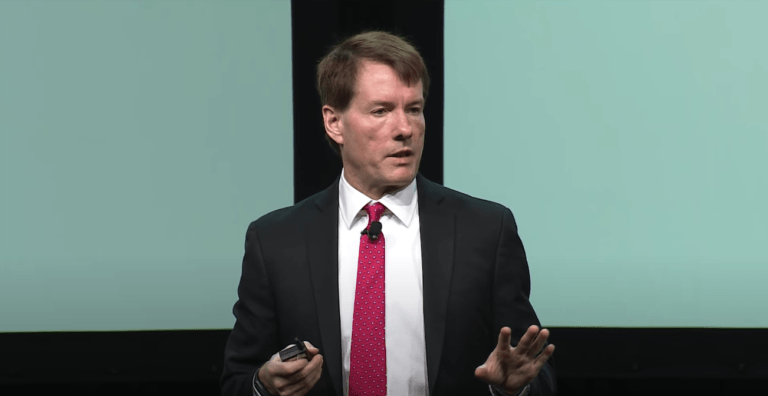Michael J. Saylor, Co-Founder, Chairman, and CEO of Nasdaq-listed business intelligence companyMicroStrategy Inc. (NASDAQ: MSTR), recently talked about how they might want to generate yield from their Bitcoin holdings, as well as how his firm’s stock compares to Bitcoin ETFs.
On 11 August 2020, MicroStrategy announced via a press release that it had “purchased 21,454 bitcoins at an aggregate purchase price of $250 million” to use as a “primary treasury reserve asset.”
Saylor said at the time:
“Our decision to invest in Bitcoin at this time was driven in part by a confluence of macro factors affecting the economic and business landscape that we believe is creating long-term risks for our corporate treasury program ― risks that should be addressed proactively.“
Since then MicroStrategy has continued to accumulate Bitcoin and its CEO has become one of Bitcoin’s most vocal advocates. MicroStrategy’s latest $BTC purchase, which Saylor tweeted about on February 1, means that the firm is now HODLing around 125,051 bitcoins, which were “acquired for ~$3.78 billion at an average price of ~$30,200 per bitcoin.”
MicroStrategy’s Q4 2021 Earnings Call took place on February 1. According to the transcript by The Motley Fool, here is what Saylor had to say about the Bitcoin side of MicroStrategy’s business:
“I will just comment on our business strategy. We have two: our business intelligence strategy and our Bitcoin acquisition strategy. With regard to business intelligence, our path forward is to continue to improve the product to rotate our revenues from enterprise-software-based to cloud-based.
“And to general — to continue to grow our installed base, we had 6% top-line growth last year. That was awesome. I expect we’ll continue to grow the business either by taking advantage of special marketing opportunities that our brand brings us for sales activity. And then we will continue to refine and automate the processes with which we provide our products and our services to our customers.
“So, that’s a mature but balanced, well-understood enterprise software business, and it’s generating excellent free cash flows for us, cash flows in excess of what we need to reinvest in order to grow the business. So, that leads us to our second strategy, which is Bitcoin acquisition strategy. We’re going to continue to reinvest our free cash flows from the core business into Bitcoin. This morning, we announced we’d acquired $25 million worth of additional Bitcoin from free cash flow.
“I think that’s a powerful strategy for us, and it’s working well. Obviously, we’ll hold the existing Bitcoin. We’ve crossed 125,000 Bitcoin now. And as Phong had pointed out, much of that coin is not pledged as collateral.
“So, the company maintains options that we can consider, and we’ll consider different options from time to time to put more leverage on that collateral or to generate yield on those assets if we find a compelling opportunity that we feel would be accretive and appropriate to our risk parameters. As Phong has said, we haven’t really decided anything, and we don’t have any particular intent right now. But the option to pursue either leverage or yield or other kinds of strategic partnerships using our billions of dollars of Bitcoin, I think, is very important and it’s an important benefit to our shareholders. And it’s a way in which we will look to build shareholder value.
“When you’re considering MicroStrategy, clearly, you can look at us as a software company. And I think people are going to evaluate our revenue growth rate. They’re going to look at our ability to generate free cash flow, our efficiency. And they’re going to also look at our progress in migrating to a cloud-first business model.
“And right now, we’ve got a very rapid growth rate to the cloud. So, we’re very pleased about that. When considering the Bitcoin MicroStrategy side of the business, I think that investors will compare us to ETFs or other sorts of Bitcoin operating companies. And I think investors understand if they invest a certain sum of money in an ETF, which is futures-based, there’s a substantial cost each year in excess of 2% and potentially much, much higher to roll over the futures.
“And so, holding a spot ETF would be more desirable than our futures ETF if you’re concerned about the carrying cost over the course of a decade or even a year. There is no spot ETF available for Bitcoin right now, which means that current investors can compare us to, say, a gray-scale product, which has a multi-percent yield — sorry, multi-percent cost, 2% or slightly more than that. If there ever is a Bitcoin spot market ETF, it would be 50 to 100 basis points cost annually for investors. MicroStrategy is in a fortunate situation because we are an operating company that generates free cash flow.
“And so, rather than paying 1% of your Bitcoin per year or a 1% fee to hold it, we’re actually acquiring Bitcoin via free cash flow from time to time. And so, if you compare us to various spot and futures ETFs, I think we compare very favorably because we are an efficient operating company. If you compare us to other operating companies in the Bitcoin space, we’re not a Bitcoin miner. So, we don’t have the same kind of capital obligations or competitive uncertainties that a Bitcoin miner has.
“And I think that if you are an investor in Bitcoin miners, then, of course, it’s reasonable to invest in them. But if you’re looking for an operating company that’s going to acquire more Bitcoin that isn’t subject to the competitive and uncertain dynamics of the mining business, then MicroStrategy is a fairly unique player in the space. So, we feel that our Bitcoin strategy is really accretive to our business intelligence strategy. And our business intelligence strategy is very accretive, very beneficial to our Bitcoin strategy.
“And it’s worked together well. I think it’s elevated our brand. It’s opened up new sales opportunities for us, new marketing opportunities for us. And of course, being able to channel our proceeds from our software business into the Bitcoin strategy, I think, is a great opportunity and we’ll pursue that.“
Saylor also talked about the outlook for Bitcoin:
“With regard to the outlook to Bitcoin, I think that in the last 12 months, the asset classes has evolved and matured. I see evidence of a lot more institutional adoption, greater adoption among macro and other hedge funds. We’ve made great progress with corporations. There will be 24 publicly traded Bitcoin miners by the end of the quarter, so lots of publicly traded companies in the Bitcoin space, more and more publicly traded companies holding Bitcoin on their balance sheets, more and more public investors with Bitcoin exposure, more banks rolling out Bitcoin acquisition and trading and custody services, more regulatory awareness, and more clarity as to how the entire crypto industry is going to evolve.
“I think these are all good things for the asset class and they’re positive developments. In the rest of the world, many of the macroeconomic developments have elevated the stature and the awareness of businesses and investors in the rest of the world to Bitcoin. The circumstances and the currency volatility in Turkey, the currency volatility in South America, the currency volatility in Africa, all of these things have elevated institutional awareness of Bitcoin. Of late, in the past month, the capital markets volatility, the volatility of equities, the S&P Index, the volatility of NASDAQ, of big tech stocks, all of these things have elevated mainstream investors’ awareness to Bitcoin.
“And there’s a growing sentiment that we see across the mainstream that Bitcoin is here to stay. The crypto economy represents a great opportunity for the entire world. And politicians and investors and corporations are working diligently to come to terms on what this means and how they should adjust their practices. I see all these things as very positive steps forward versus where we were a year ago.
“I’m really hard-pressed to think of any material developments in the past 12 months that are putting us at a disadvantaged situation versus a year ago. I think generally, we’ve had a passage of positive developments. And we look forward to the next wave of institutional adoption that, I think, should be driven as people get more educated and more aware of what digital property is. And as all of the various vendors in the space, all enhance their product offerings and their service offerings in order to make adoption of digital assets and Bitcoin in specific easier.“
Disclaimer
The views and opinions expressed by the author, or any people mentioned in this article, are for informational purposes only, and they do not constitute financial, investment, or other advice. Investing in or trading cryptoassets comes with a risk of financial loss.









